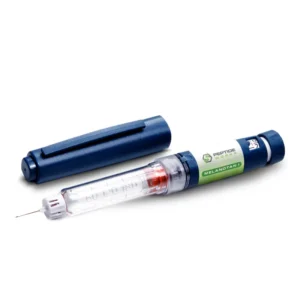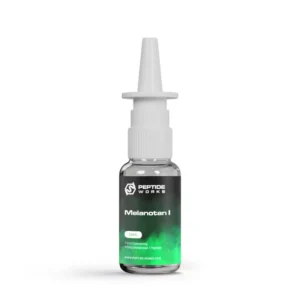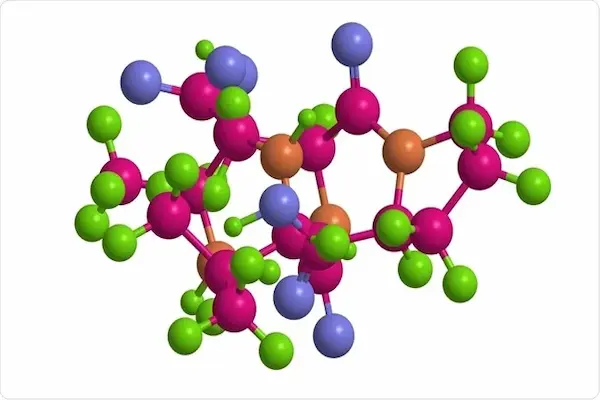PROMO!
First order? Get 10% OFF with this code: 1storder
Our Product Categories



Melanotan I or MT-1 is a synthetic analog of the naturally occurring alpha-melanocyte-stimulating hormone (α-MSH). This peptide belongs to the melanocortin family and is primarily known for its role in stimulating melanin production in the skin. Melanin is the pigment that gives color to your skin, hair, and eyes. It also helps protect your skin from ultraviolet (UV) rays.
MT-1 was originally developed as a potential therapeutic agent for conditions like erythropoietic protoporphyria (EPP) and other photosensitivity disorders, where increased melanin production could reduce UV-induced damage.
Peptide Sequence (IUPAC Condensed): Ac-Ser-Tyr-Ser -Nle-Glu -His-D-Phe-Arg-Trp-Gly-Lys- Pro-Val-NH2
Molecular Formula: C78H111N21O19
Molecular Weight: 1646.8 g/mol
Synonyms: Melanotan 1, MT-1

Melanotan I works by mimicking alpha-melanocyte-stimulating hormone (α-MSH). It attaches to melanocortin 1 receptors (MC1R) on melanocytes, which are the cells that produce melanin. This action starts a key process called the cyclic adenosine monophosphate (cAMP) pathway, essential for making melanin. As a result, the body produces eumelanin, a darker type of melanin that also protects against UV radiation.
Increased Skin Pigmentation / Sunless Tanning: Research on Melanotan-1 (MT-1) has shown it enhances skin pigmentation by stimulating melanin production, leading to a tanning effect. Clinical trials demonstrated that MT-1, combined with UV-B light or sunlight, significantly increased tanning while reducing sunburn cells [1].
Studies demonstrated that higher doses produced more pronounced and longer-lasting pigmentation compared to sunlight alone. Side effects were minor, including nausea and facial flushing. While MT-1 shows promise for safe tanning, concerns about unregulated products and long-term health effects warrant further investigation [2].
Photoprotection and Sun-Sensitivity Treatment: Research has demonstrated that Melanotan-1 provides photoprotection and treats sun sensitivity by stimulating eumelanin production through melanocortin-1 receptor activation. It is particularly effective for erythropoietic protoporphyria (EPP), a condition causing severe phototoxicity [3].
Clinical studies show afamelanotide significantly increases sunlight tolerance, reduces pain from light exposure, and improves quality of life for EPP patients. Administered subcutaneously, it enhances pain-free time in sunlight and is well-tolerated, with minor side effects like headache and nausea [4].
Promising Therapies for Skin Conditions: Research suggests that Melanotan-1 shows promise as a therapy for skin conditions like vitiligo by stimulating melanogenesis and promoting repigmentation. Vitiligo, characterized by the loss of melanocytes and resulting white macules, lacks a definitive cure.
Melanotan-1’s ability to activate melanocortin-1 receptors and enhance eumelanin production offers a regenerative approach to restore pigmentation. While further research is needed, its potential to stabilize depigmentation and induce durable repigmentation makes it a promising option for vitiligo management [5].
[1] R T Dorr, G Ertl, N Levine, C Brooks, et al (2004) Effects of a superpotent melanotropic peptide in combination with solar UV radiation on tanning of the skin in human volunteers – Archives of Dermatology, 2004 Jul, Volume 140 (Issue 7), Pages 827-35.
[2] R Brennan, J G Wells, and M C Van Hout (2014) An unhealthy glow? A review of melanotan use and associated clinical outcomes – Performance Enhancement & Health, Volume 3, Issue 2, June 2014, Pages 78-92.
[3] D Wensink, M A E M Wagenmakers, and J G Langendonk (2021) Afamelanotide for prevention of phototoxicity in erythropoietic protoporphyria – Expert Review of Clinical Pharmacology, 2021 Feb, Volume 14 (Issue 2), Pages 151-160.
[4] A Polańska, J Wegner, P Nutbohm, et al (2024) Afamelanotide in protoporphyria and other skin diseases: a review – Postepy Dermatology Allergology, 2024 Apr 12, Volume 41 (Issue 2), Pages 149–154.
[5] B Bellei, F Papaccio, and M Picardo (2022) Regenerative Medicine-Based Treatment for Vitiligo: An Overview – Biomedicines, 2022 Oct 28, Volume 10 (Issue 11), Page 2744.
The answers to the most frequently asked questions about Melanotan 1.

Buy Melanotan 1 Peptide Nasal Spray from Peptide Works. Available in 15 ml and 30 ml glass spray bottles, this non-invasive administration route for research offers a convenient and effective way to ensure consistent application.
Melanotan 1 may show mild side effects in research studies. Reports describe nausea, flushing, headache, and temporary skin darkening. Some tests show small changes in moles or freckles. Injection-site redness or pain can occur. Results can vary based on dose, purity, and storage during experimental use.
Melanotan 1 is not approved by the U.S. Food and Drug Administration (FDA) for tanning or cosmetic use. It is available only for authorized research and development purposes. Usage rules and regulatory status can vary between countries, so buyers should follow local guidelines.
There is no scientific evidence that Melanotan 1 increases libido. Reported sexual-arousal effects are linked to Melanotan 2, which targets additional melanocortin receptors. Research shows Melanotan 1 mainly affects skin pigmentation pathways and has not demonstrated libido-related effects in controlled studies.
Current studies show Melanotan 1 increases melanin synthesis through melanocortin receptor activation, which may enhance photoprotection in research models. However, it is not recognized as a sunscreen agent and should not be considered a substitute for UV protection. Researchers continue to study its role in pigmentation and light-exposure tolerance.

This blog explores the differences between Melanotan 1 and Melanotan 2, two peptides known for enhancing tanning by stimulating melanin production. It looks at their individual mechanisms, receptor activity, effects, and possible side effects to help researchers better understand their use in pigmentation, metabolism, and other related studies. A complete and practical guide for making informed research decisions!

The blog explores the Melanotan peptide, a research compound studied for its effects on skin pigmentation, UV protection and metabolism. It delves into the roles of MC1R and MC4R receptors, compares Melanotan 1 and 2 and highlights their distinct properties. Emphasizing research only use, it provides insights into ongoing peptide studies.

This blog explores peptide tanning, a scientific approach to enhancing skin pigmentation without sun exposure. It examines how peptides like Melanotan 1 and 2 stimulate melanin production, their unique effects and their role in pigmentation research. Learn about their benefits, mechanisms and potential for safer, controlled tanning solutions.
ALL CONTENT AND PRODUCT INFORMATION AVAILABLE ON THIS WEBSITE IS FOR EDUCATIONAL PURPOSES ONLY.
DISCLAIMER: These products are intended solely as a research chemical only. This classification allows for their use only for research development and laboratory studies. The information available on our Peptide Works website: https://peptide-works.com/ is provided for educational purposes only. These products are not for human or animal use or consumption in any manner. Handling of these products should be limited to suitably qualified professionals. They are not to be classified as a drug, food, cosmetic, or medicinal product and must not be mislabelled or used as such.